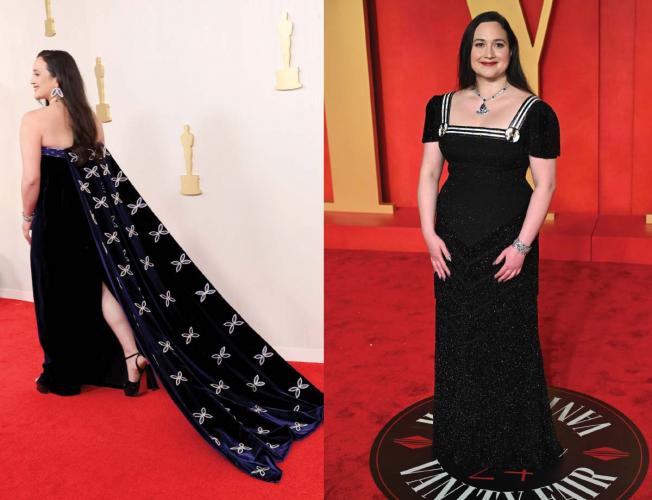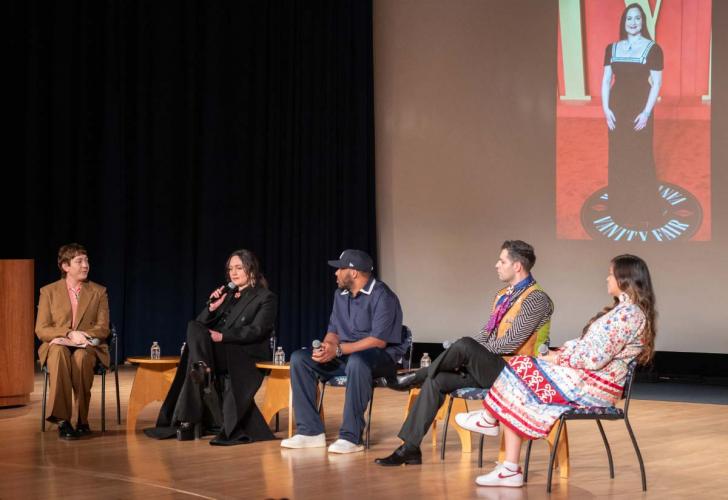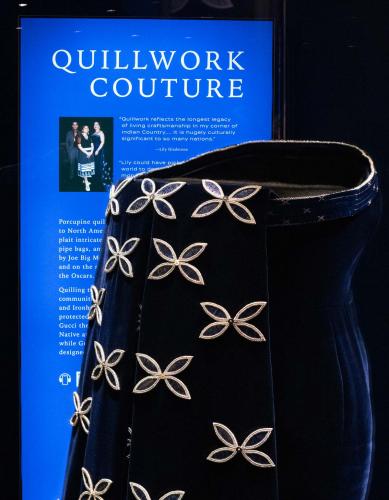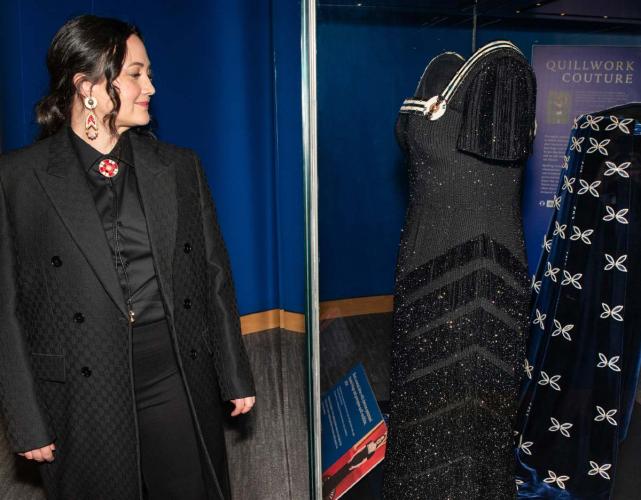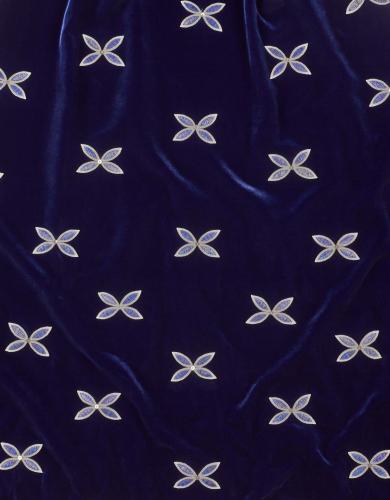On the evening of March 10, 2024, millions of television viewers watched as Lily Gladstone walked down the red carpet at the 96th Academy Awards at the Dolby Theatre in Hollywood, Los Angeles. This was a historic moment. Gladstone, who is of Siksikaitsitapi (Blackfeet)/Nimiipuu (Nez Perce) heritage, is the first American Indian woman to be nominated to receive an Oscar for Best Actress. She was chosen for her portrayal of Mollie Burkhart in the film “Killers of the Flower Moon,” and she wanted to use her moment in the spotlight to make a statement—not only by what she said but by what she wore.
Gladstone’s first gown of the evening was a midnight-blue velvet dress that was adorned with an Indigenous-designed, porcupine-quill neckline and a matching cape that was covered with 216 hand-quilled and beaded flower designs. Her second gown, which she wore later at the Vanity Fair Oscar party, was a black, corseted dress that also features a hand-quilled neckline. Additionally, this intricately designed gown has chevron-patterned glass-beaded fringe, 24-karat-gold–plated beads and brass sequins.
Gladstone chose to wear gowns that were adorned by Indigenous-made designs because “It’s always been a dream of mine since I've imagined a career as an actor,” she said, “that were I to ever grace any red carpet that I would really want to highlight particularly the artistry of quillwork. It’s one of the oldest forms of arts as adornment on the North American continent, and I remember it being really the first work that I admired.”
One of the first jewelry purchases she made was a pair of quill earrings. Such Indigenous quillwork is unique to North America—an art form that has been practiced for at least 1,400 years.
A Historic Collaboration
Gladstone’s journey to grace the red carpet began on the Blackfeet Indian Reservation in Montana where she was born. She said she first knew she wanted to be an actor when she was 5 years old after watching “Return of the Jedi.” As a young adult, she would go on to earn a Bachelor of Fine Arts in acting and directing and a minor in Native American studies from the University of Montana in 2008.
In 2012, Gladstone made her independent film debut in “Jimmy P: Psychotherapy of a Plains Indian” at 26 years old. She then appeared in such films as “Certain Women” (2016), “First Cow” (2019), “The Unknown Country” (2022) and “Fancy Dance” (2023). Gladstone has also appeared in television programs such as “Billions” (2019–2023) and “Reservation Dogs” (2022–2023). For her acting, Gladstone has been nominated for and received a plethora of awards, including a Screen Actor’s Guild Award for Best Actress for her role in “Killers of the Flower Moon” in 2024 and the Gotham Independent Film Award for Outstanding Lead Performance for her role in “The Unknown Country” in 2023.
After “Killers of the Flower Moon” was released, Joe Big Mountain (Mohawk/Cree/Comanche) of Ironhorse Quillwork sent Gladstone a necklace and earrings and Gucci gave her a suit to wear at special events. When Gladstone had received a nomination for Best Actress from the Academy of Motion Picture Arts and Sciences, she consulted with stylist Jason Rembert about what she should wear. She then approached Gucci and told them she wanted to invite Joe and his wife, Sunshine Big Mountain (Oneida Nation), to collaborate on Gladstone’s gowns at the company’s offices in Italy.
Joe remembers the call from a member of Gladstone’s team inviting them to Rome. “He calls me and he's so casual. He says, ‘Hey, you know, I want to fly you guys out to Italy. I want you guys to work with Gucci.’ And me and my wife are looking at each other like, what?’ We really were just completely blown away.”
At Ironhorse Quillwork on the Oneida Nation's Reservation in Wisconsin, Joe focuses on the art while Sunshine handles the operations of their business. The team knew this project would be a huge undertaking. One of their concerns was that international airports security might not allow porcupine quills to be transported into the country. However, their travel to Italy went smoothly, and when they arrived, they headed straight to Gucci’s design offices.
There they learned they would have less than three weeks to complete the quillwork on both dresses. Gucci suggested that members of their design team could assist, but another significant concern for Gladstone and the quill artist team was the potential for cultural appropriation. If Joe taught artists at Gucci how to do quillwork as he does, he was worried they might use similar techniques and designs in the future. Joe and Sunshine explained that their quillwork techniques and practices are protected. Instead, they came up with their own solution. They assembled a team of Indigenous artists on the Oneida Nation’s Reservation to help adorn the gowns.
“We chose artists that we knew personally and people who were referred to us by other people in the community who they knew could devote a constant work schedule,” Joe said. “Having everyone on the team be an artist in their own way, we grouped people together to focus on certain aspects of the project based on their strengths.”
Designated quillworkers included Kendrick Powless-Crouch (Oneida/Yakima/Skokomish) and Jossalyn Metoxen (Oneida). Beadworkers included Seven Oshkabewisens (Mohawk/Cree/Comanche), Dionne Jacobs (Oneida) and Aryien Stevens (Seneca). And Paige Skenandore (Oneida) sorted the quills needed for the blue velvet gown. The team focused on creating the petals on the blue gown by day, and Joe and Powless-Crouch worked exclusively on the black dress at night, right up until the night of the Academy Awards.
Joe spent the first couple of days teaching the other artists his technique, which included sewing the quills down with a zigzag stitch and finishing the petal designs with a two-needle beaded edge. They had a lot of work to do to adorn the dresses in a short amount of time, so they sewed nearly nonstop. “We worked on the petals for roughly 10 days. We needed to find fast learners, and it paid off.”
Gladstone was exuberant with the gowns and, most significantly, how they were made. She said of Gucci’s efforts to avoid cultural appropriation, “It was a really remarkable thing to have the artistry and have the artisans respected—to have their wishes and their concerns be not just addressed but fully respected. As you can see, the result is absolutely stunning.”
Gladstone chose to wear the black dress not only at the Academy Awards in 2024 but again at the Screen Actor Guild Awards in 2025. Sunshine recognized the importance of Gladstone wearing these gowns at such events. “She has used her career to spotlight Indigenous people and artists, and she doesn’t have to do that,” she said. “When she came out [at the Academy Awards], people were just expecting her to wear earrings and a necklace, … but Lily comes walking out in a huge velvet gown draped with quillwork over the entire thing,” she recalled. “It was the biggest shock.”
Although Gladstone did not receive the Oscar, she did win a Golden Globe for Best Actress in 2024. When Gladstone accepted the award, she thanked the audience in her Blackfeet language.
Gucci at the NMAI
In celebration of Gladstone’s momentous achievements and to highlight the collaboration between her, Gucci and Ironhorse Quillwork, the National Museum of the American Indian in Washington, D.C., is displaying these two gowns at a special installation titled “Making a Statement” through March 2026. “The elegant designs mark the first Oscars collaboration between an Indigenous artist and a luxury fashion brand like Gucci,” said NMAI Curator Anya Montiel (Mestiza/Tohono O’odham descent).
She said the idea for the installation was inspired by Gladstone herself. “The other curators and I noticed that Lily Gladstone had worn clothing and jewelry by Indigenous artists on the red carpet and in fashion editorials,” said Montiel. “Gladstone has been such an advocate for Indigenous artists and designers. She doesn’t just wear the pieces—she uplifts the artists and brings awareness to Indigenous artistry.”
Yet getting these dresses to the museum wasn’t a sure thing. “Since actors don’t keep everything they wear for special events, we had no idea if the museum could acquire something Gladstone wore,” she explained. But upon approaching Gladstone’s publicist, Jill Kaplan, she confirmed the two gowns could be loaned to the museum.
Montiel said that the installation is an opportunity to educate visitors about porcupine quillwork. For centuries, Indigenous artists have used porcupine quills to appliqué, embroider, wrap or plait intricate designs onto clothing, moccasins, jewelry, pipe bags and birchbark containers, many examples of which are in the NMAI collection. Montiel said, “The Gladstone gowns confirm that quillwork is an ancient and thriving art form.”
In the installation, Gladstone says through an audio recording, “This world is a gift to us. It’s something we take care of. And part of that relationship that we have with our Creator, with our Earth, with our environment and with ourselves is to make sure everything is beautiful.”
On March 14, the NMAI hosted a special event that featured a panel discussion among Gladstone, stylist Jason Rembert and Joe and Sunshine that was moderated by the Senior Fashion and Style Writer at Vogue, Christian Allaire (Ojibwe). Gladstone said, “I believe Gucci itself is an adjective for the finest. And I feel like through this collaboration, when you look at it, hopefully quillwork becomes the same adjective.” She added, “I know that for Indian Country, Ironhorse Quillwork particularly is one of the more refined names that we recognize in the art form. The collaboration of the two felt very natural, very beautiful. And as it turns out, one that hopefully will set the precedent for this kind of collaboration in the future.”

